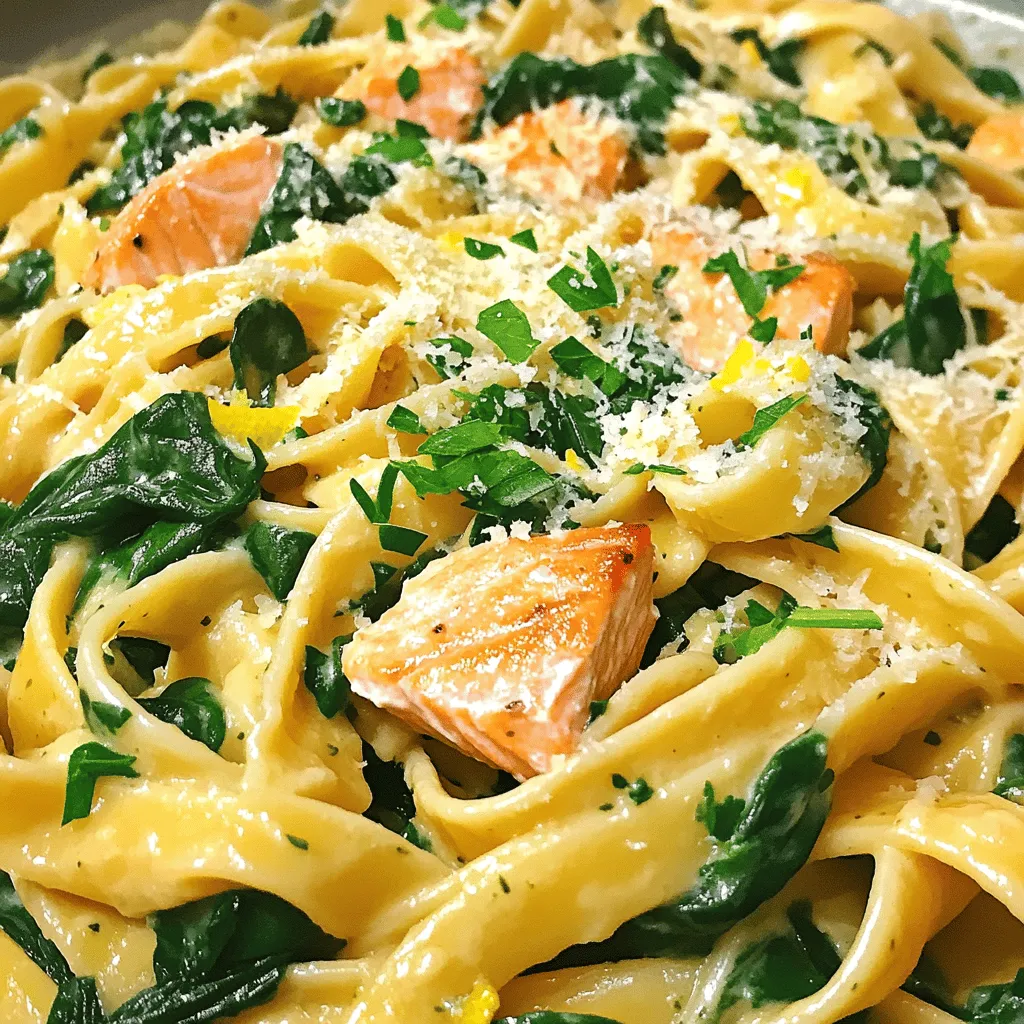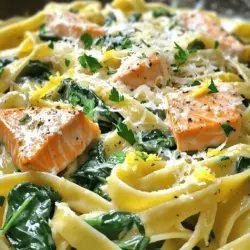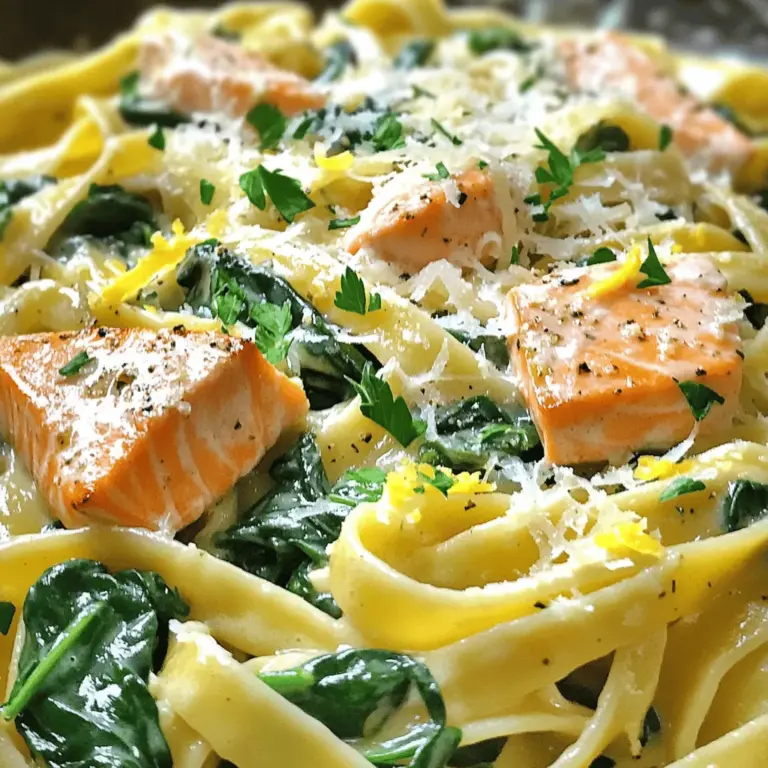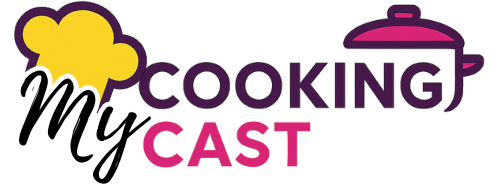Looking for a speedy yet delicious dinner option? This Creamy Garlic Salmon Pasta hits the mark! With just a few simple ingredients, you can whip up a flavorful meal in no time. Whether you’re cooking for your family or impressing guests, this dish is sure to please. Join me as I guide you through each step, share handy tips, and suggest tasty variations. Let’s make weeknight dinners exciting again!
Ingredients
Main Ingredients for Creamy Garlic Salmon Pasta
To make this dish, you need the following key ingredients:
– 8 oz fettuccine or spaghetti
– 2 salmon fillets (about 6 oz each)
– 2 tablespoons olive oil
– 4 cloves garlic, minced
– 1 cup heavy cream
– 1 cup grated Parmesan cheese
– 1 cup baby spinach
– 1 lemon (zested and juiced)
– Salt and pepper to taste
– Fresh parsley, chopped (for garnish)
These ingredients create the rich flavors in the creamy garlic sauce. The salmon provides a lovely, flaky texture. The pasta absorbs the sauce well, making each bite delicious.
Optional Ingredients for Flavor Enhancements
To take your dish to the next level, consider adding:
– Red pepper flakes for heat
– Capers for a briny kick
– Sun-dried tomatoes for sweetness
– Fresh basil or dill for herbaceous notes
These optional ingredients can add depth and excitement. You can mix and match based on what you enjoy most.
Recommended Tools and Equipment
You will need a few simple tools to prepare this meal:
– Large pot for cooking pasta
– Large skillet for the sauce and salmon
– Colander for draining pasta
– Zester or grater for lemon zest
– Wooden spoon or spatula for mixing
Having the right tools makes cooking easier. These utensils help you work efficiently and keep your kitchen organized.
Step-by-Step Instructions
Cooking the Pasta
Start by boiling a large pot of salted water. Add 8 oz of fettuccine or spaghetti. Cook it according to the package until it is al dente. This usually takes about 8-10 minutes. Once done, reserve 1 cup of pasta water. Drain the pasta and set it aside for later.
Preparing the Salmon
While the pasta cooks, take 2 salmon fillets and season them with salt and pepper. In a large skillet, heat 1 tablespoon of olive oil over medium heat. Place the salmon in the skillet skin-side down. Cook for 5-6 minutes until the skin is crispy. Flip the fillets and cook for another 2-3 minutes until they are fully cooked. Remove them from the skillet and flake them into bite-sized pieces.
Making the Creamy Garlic Sauce
In the same skillet, add another tablespoon of olive oil. Sauté 4 minced garlic cloves over medium heat for about 1 minute until fragrant. Pour in 1 cup of heavy cream and stir it gently. Bring the mixture to a gentle simmer.
Combining Ingredients
Now, stir in 1 cup of grated Parmesan cheese until it melts and combines with the cream. Then, add 1 cup of baby spinach and cook for 2 minutes until the spinach wilts. Add the drained pasta to the skillet, tossing it well in the creamy garlic sauce. If the sauce seems too thick, add some reserved pasta water until you like the consistency.
Serving Suggestions
Gently fold in the flaked salmon, along with the juice and zest of 1 lemon. Mix everything well, then taste. Adjust the seasoning with more salt and pepper if needed. Plate the pasta and sprinkle fresh chopped parsley on top for a nice touch. Enjoy your delicious Creamy Garlic Salmon Pasta!
Tips & Tricks
How to Achieve Perfectly Cooked Salmon
To get perfectly cooked salmon, start with fresh fillets. Look for bright color and no strong smell. Season each side with salt and pepper. Heat olive oil in a skillet over medium heat. Lay the salmon skin-side down. Cook for about 5 to 6 minutes. You want crispy skin! Flip the salmon over and cook for another 2 to 3 minutes. Check that it flakes easily with a fork. This method gives you juicy salmon that pairs well with pasta.
Adjusting the Creamy Sauce Consistency
The creamy sauce is key to this dish. If it is too thick, add reserved pasta water slowly. Start with a few tablespoons and stir. Keep adding until it reaches your desired creaminess. If it is too thin, let it simmer a little longer. This will help thicken it naturally. You can also add more cheese for extra richness.
Best Practices for Pasta Cooking
Cooking pasta may seem easy, but there are tricks. Always use a large pot with plenty of water. Add a good amount of salt to the water for flavor. Stir the pasta to prevent sticking. Cook until al dente, which means firm to the bite. Save some pasta water before draining. This water helps to bind the sauce and pasta together. Follow these steps for perfect pasta every time.

Variations
Different Types of Pasta to Use
You can switch up the pasta in this dish. Fettuccine and spaghetti are great, but other types work too. Consider using penne, farfalle, or even whole wheat pasta for a healthy twist. Each type brings its own texture and taste, adding fun to the meal. Just remember to cook according to package instructions for the best results.
Adding Vegetables for Extra Nutrition
Boost the nutrition by adding vegetables. Baby spinach is a classic choice, but you can add others too. Try cherry tomatoes for a burst of flavor or zucchini for a nice crunch. Broccoli or asparagus can also add great color and health benefits. Adding veggies makes the dish more colorful and satisfying.
Alternatives for Creamy Sauce
If you want a lighter sauce, there are great alternatives. You can use Greek yogurt or a dairy-free cream. These options cut some fat but keep that creamy feel. Adding a splash of vegetable broth can also bring flavor without heavy cream. Play around to find what you like best.
Storage Info
Best Practices for Storing Leftovers
After you enjoy your creamy garlic salmon pasta, store any leftovers in an airtight container. This keeps the pasta fresh. Let it cool to room temperature before sealing. Always place it in the fridge within two hours. The leftovers will stay good for up to three days.
Freezing Creamy Garlic Salmon Pasta
You can freeze creamy garlic salmon pasta for later enjoyment. First, let it cool completely. Then, place it in a freezer-safe container. Be sure to leave some space at the top for expansion. This dish can last up to three months in the freezer. When you want to eat it again, just thaw it overnight in the fridge.
Reheating Tips for Retaining Flavor
To reheat your creamy garlic salmon pasta, use a skillet for best results. Add a splash of water or cream to keep it moist. Heat it over low to medium heat. Stir often until it warms through. You can also use the microwave, but cover it to avoid drying out. Enjoy your meal just like the first time!
FAQs
Can I use frozen salmon for this recipe?
Yes, you can use frozen salmon. Just thaw it first. Thaw it overnight in the fridge or for a few hours in cold water. Once thawed, it cooks just like fresh salmon. The flavor stays great, and the dish will still taste amazing.
What can I substitute for heavy cream?
You can use half-and-half or whole milk with butter. For a lighter option, try Greek yogurt or cashew cream. Each swap changes the texture and taste a bit, but they all work well in this dish. Just keep in mind that heavy cream gives the richest flavor.
How long does the dish last in the fridge?
This dish lasts for about 3 days in the fridge. Store it in an airtight container to keep it fresh. When you’re ready to eat, just reheat it gently on the stove. Add a splash of water or broth to help it stay creamy.
Can I make this recipe without pasta?
Yes, you can! Try serving the creamy salmon over rice or quinoa. You could also use zucchini noodles for a low-carb option. The creamy garlic sauce works well with many bases, so feel free to get creative with your choice.
This blog post covered all you need to make creamy garlic salmon pasta. I detailed the main and optional ingredients, plus tools you’ll need. You learned step-by-step instructions and helpful tips for perfect salmon and sauce. We also explored pasta variations and smart storage methods.
In summary, you can create a delicious meal that everyone will enjoy. Simple changes can make a big difference. Now, grab your ingredients and start cooking!


